https://www.blogger.com/blogger.g?blogID=3651317526424928102#editor/target=post;postID=4542851383654673738
Optimizing your online marketing sales funnel is a constant effort of testing and tweaking, long hours spent creating content for every lead segment imaginable, A/B tests that confound you, and open rates that boggle the mind.
Sometimes it’s good to know you’re not alone.
This article will take you through the steps of a cohesive marketing campaign for SaaS businesses. Rather than a typical walkthrough, I’ll be offering advanced techniques for maximizing the conversion potential of each step. Feel free to ask questions in the comment section below.
Throughout this article, I’ll be using a business I made up as an example. Please meet CRM Unlimited, Canada’s up-and-coming CRM software provider for small businesses:
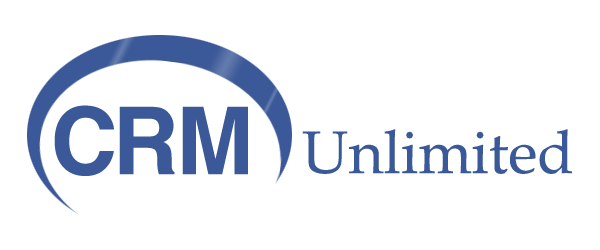
I’ll be taking this burgeoning startup through a lead generation campaign. Here’s a short outline:
- Create an optimized landing page
- Drive traffic with online advertising
- Retarget bounced traffic with a WCA
- Retarget bounced traffic on the Google Display network
- Create an optimized “thank you” page
- Nurture leads with email automation and digital touch points
For each step, I have created examples that show how simple it is to build an optimized online marketing campaign.
1. Create a Landing Page
Each campaign you run should have its own corresponding landing page. Each campaign should have its own color scheme, advertisements, segment of leads, and remarketing campaign (all of which I’ll discuss). First, we must create CRM Unlimited’s lead generating landing page.
Here’s what it might look like:

Maximize this page’s potential for conversion:
- Match your copy: Ensure you’re using the copy that will work in your online ads (and vice versa). This has a two-fold effect on your campaign:
- It increases the chance of a conversion by keeping your message tight and your visitors comfortable, thereby decreasing landing page bounce rates.
- It increases your Google Quality Score (which you know is good).
- Implement exit pop-ups: Exit pop-ups are triggered when your landing page traffic drags their cursor to the top pixel of the screen. While these are definitely something worth testing, many businesses have found success implementing this addition. I recommend making it physically easy for your traffic to exit the pop-up, but justifiably difficult. For instance, feature two CTAs in your pop-up: an easy-to-click “Yes, I’d like to improve my [current, negative state]” and a less justifiable “No, I’m happy with my [current, negative state].”
- Focus form fields: Available with many template providers (usually only in the Pro-Plan or its equivalent), “focus form fields” allow you to automatically pre-select an entry form field. This means that your traffic can immediately start typing their details without having to find the form field and click on it. Here’s what it looks like (on the right):

While this may look like a small and unimportant detail, seasoned A/B testers know those are often the most influential. This small change has proven (in our own A/B tests) to have increased page conversions by 56%. Here’s proof I’m not messing around:
Other elements I’d test:
- The customer testimonial: While customer testimonials often increase conversion rates, this is not necessarily true of lead gen pages, where they can prove a distraction. I’d test including this one before moving forward.
- The “about us” section: Landing page traffic entirely unfamiliar with your business may appreciate a short “about us” section on your lead gen page. However, like customer testimonials, it may be an unnecessary distraction.
- The CTA button color and text: Always worth testing (though not always worth testing immediately), CTA button color changes have proven to increase conversion rates by up to 32.5%.
2. Create an Online Ad
Step two of your campaign is generating an online advertising presence. I’ve found more lead generation success with Facebook Ads than AdWords, so that’s the angle we’ll be taking in this example.
Why Facebook instead of Google?
Remember, I’m just talking lead gen here. Free trial promotion or straight sale is an entirely different matter. For lead generation, however, Facebook gives us a platform where we can target people we know are interested in our subject matter. Google gives us a platform where very few people are searching for our content. Instead, they’re searching for products and services (a different funnel than we’re discussing here).
You also have to consider advertising ROI. Competing with keywords like “CRM,” “customer relationship management,” or “small business” may be worth it for advertisements promoting your tool, but it may not be worth it for your lead gen campaigns.
Facebook, on the other hand, has an incredibly competitive pricing structure. In fact, targeting a Facebook Ad at small business owners who are interested in customer relationship management in the US, Australia, the UK, and Canada will cost about 70-80 cents per click, with an estimated reach of about 220,000 people. With a .1% click-through-rate, you’ll drive 220 people to your landing page and pay $165 total. If your page is converting at 20%, you’ll generate 44 leads with a cost per lead of $3.75.
Here’s what CRM Unlimited’s Facebook Ad might look like:
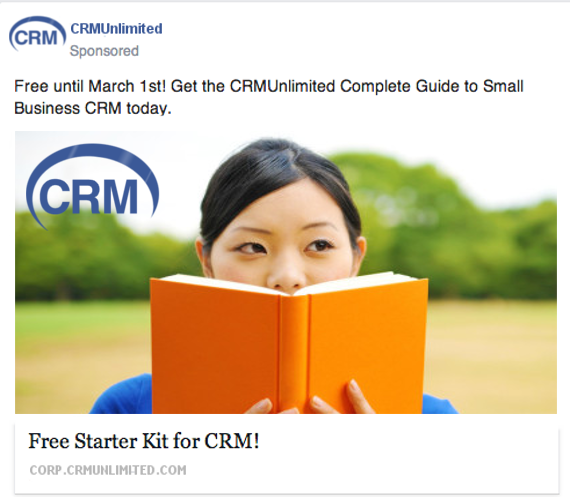
Maximize this ad’s potential for conversion:
- Target specifically: Facebook Ads now can be targeted by job title and business name as well as traditional interest targeting (such as users who “liked” CRM providers in the past or expressed interest in customer relationship management).
- Keep your audience tight: Condense your target market to between 100,000 and 250,000 users.
- Design to catch the eye: Oranges, reds, and greens will stand out from the Facebook newsfeed, as will pictures of people (especially smiling people), words like “Free,” your logo, and the exclusivity of end dates. General Facebook Ad best practices should be kept in mind.
- Don’t cheap out on your cost per click: If Facebook is recommending you bid between 51 and 90 cents, bid at the upper end of that spectrum. You want to win the ad auction and, to be honest, 80 cents per click isn’t a huge expense (especially when compared to AdWords).
- Match copy and color: Though less essential with Facebook Ads than it is with the Google platform, it’s still best practice to match your ad copy and color with that of your landing page. People who click on your ad need to know they’ve come to the right place as soon as they arrive on your landing page or they’ll bounce in the first few seconds.
3. Create a Facebook Website Custom Audience
Steps three and four of your cohesive marketing campaign are all about maximizing the chance of a possible customer engaging with your company and becoming a lead.
New strategies in online marketing are making it easier to recapture bounced landing page traffic, meaning your landing page’s conversion rates are no longer the be all and end all of your campaign’s success.
An example of this recapturing of bounced traffic is Facebook’s Website Custom Audience targeting.
It works like this:
- Facebook provides advertisers with a small section of code (a pixel) which is placed within the code of your website.
- Within Facebook’s Ad Power Editor (a Chrome plugin), you tell Facebook which page you want to collect bounced traffic from (CRM Unlimited’s e-book landing page, for instance).
- Any time that page receives web traffic (from anywhere), it triggers Facebook’s code. This code then pings Facebook with a notification.
- Facebook compiles the data from each browser that triggers their pixel, creating a “website custom audience” within your Power Editor Ad manager.
- Facebook collates the data and finds corresponding Facebook users, allowing you to target specific Facebook Ads at people who have visited your website.
Here’s what CRM Unlimited’s Facebook Ad might look like targeting a website custom audience:

You may note that this strategy is, essentially, retargeting (and it is). However, there are a couple of benefits you’re not going to get with standard retargeting:
- Generating the audience is entirely free.
- It doesn’t require a third party retargeting provider.
4. Retarget Bounced Traffic with the Google Display Network
As impressive as Facebook’s website custom audience targeting is, not all your bounced traffic will be on Facebook users. Even if they are, a sizeable portion won’t be frequent users or will hate Facebook’s Ads on principle (we all know someone like this).
That’s where retargeting (also called remarketing) enters the picture.
For those unfamiliar, here’s a lightning-fast breakdown of retargeting on the Google Display Network:
- You enter a short snippet of code (called a retargeting pixel) into the body code of your landing page.
- Think of this bit of pixel as the trigger of a gun. When landing page traffic heads to your page but doesn’t convert, this gun goes off, and fires a sticky wad of gum (or a “cookie”) onto that bounced traffic’s shoe (or browser), allowing you to track them across the web.
- When your bounced lead heads to one of a million different sites within Google’s display network (Huffington Post, Songza, Amazon, the New York Times, etc.), they are shown a retargeting ad you’ve created especially for them, encouraging them to re-engage with your business.
Let’s say that your landing page is currently converting at 10%. That means that 90% of people who visit that page bounce without converting. Retargeting allows you to re-capture those possible customers and ensures that not everyone who leaves your website disappears forever.
Currently available only through 3rd party ad software, retargeting has two primary ad platforms: the Google display network and the Facebook platform. I’ve already talked about Facebook’s website custom audiences tool (a strategy very similar to retargeting). I’ll be taking a look at retargeting on the Google Display Network in this section.
Most 3rd party software providers give you three size options for your retargeted ad: 300 x 250 px (square sidebar ads),160 x 600 px (tall, skinny sidebar ads), and 728 x 90 px (banner ads).
Here are a couple of examples of CRM Unlimited’s banner ads:
This ad would be shown to people who bounced off CRM Unlimited’s lead gen page above. The ability to show ads exclusively to people who are on a specific touch point within your sales funnel results in a very high ROI indeed. Consider, also, that retargeting gives you the ability to create product-specific ads designed for people who bounced off specific product pages.
This ad would be timed for a week or so after the initial page bounce. It promotes CRM Unlimited as a software provider instead of CRM Unlimited’s e-book. Different CTAs and different USPs shift the focus of the possible customer to what your business can provide for them.
Maximize the conversion potential of your retargeted ads:
- Sync it up: It’s vital that your retargeting data be synced accurately. Your tool needs to be able to remove a lead from your retargeting campaign once they convert on a specific action (this might not be a final sale!). If a lead has signed up for a sales call for later in the week, but your retargeting campaign stops only when they’ve converted for a free trial, they may cancel their call if you keep pushing for a conversion as they travel the web.
Bonus Step: “Thank you” Page with a Twist
Once someone downloads your email-gated content, it’s essential you have an optimized “thank you page.” Do this for two reasons: first, to thank them for downloading, and second, to promote a further conversion.
For instance, here’s what CRM Unlimited’s “thank you” page might look like:
Maximize this page’s potential for conversion:
- Pre-populated form fields: “Thank you” pages that prompt a second conversion are a great place for a pre-populated form field. Consistently testing well in our own A/B tests, and increasing conversions by 36.4% in a LeadPages test, this is a relatively new capability for non-developers interested in optimizing landing pages, as many providers are integrating it into their templates.
- Lead parameters (or lead information like name and email address) are passed through to a new page via the URL.
- It makes converting incredibly simple, as leads no longer have to re-enter their information, instead simply clicking on your CTA.
- Letter format: I highly recommend using the letter format I have above (and as KISSmetrics does in their own “thank you” pages). This format quickly and easily starts a one-on-one relationship with your leads, something you’ll cultivate in your lead nurturing campaign (below). It increases trust and decreases the chance of your lead unsubscribing as soon as they’ve gotten what they want, as it’s harder to unsubscribe from a mailing list where you know the mailer’s name.
- Pre-populated landing page copy: Okay, this doesn’t actually exist yet, but we should all be badgering our developers to get on it. Imagine if the landing page above read “Thanks for downloading, John!” Lead information has already been given to your business, why can’t we pre-populate copy like we can automated email campaigns?
5. Nurture Leads with Email Automation and Digital Touch Points
CRM Unlimited has been successful in our first-ever lead gen campaign, driving traffic from online advertisements to a short series of optimized landing pages.
The next step is to nurture these leads into concrete dollars. And, how do we do that in the most efficient way with the highest ROI?
Step 1: We create a series of timed, tested, and segmented emails. Here’s where many articles would give you a chronological breakdown of your marketing automation campaign. Something like this:
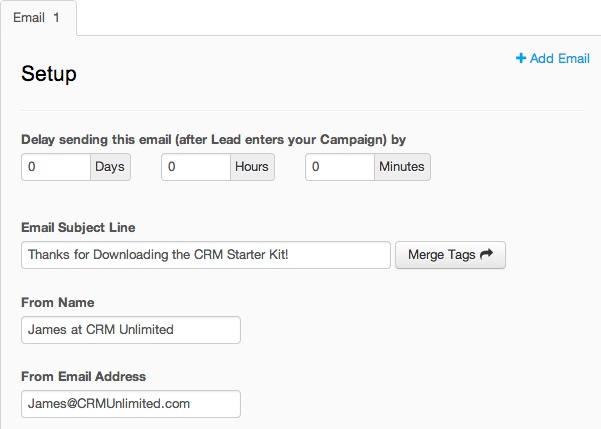
However, I’m not going to do that. Instead, I’m recognizing that you likely already have a lead-nurturing drip campaign, and have read enough articles about timing your marketing emails to maximize the chance of a conversion.
Here are a couple of more advanced techniques that will optimize your email automation strategy and move these leads down the sales funnel from “engaged” to “ready-to-buy.”
- Auto-Submit links: Auto-submit links are awesome for free demo signups, webinar registrations, and “book a time to talk” links. Basically auto-submit links skip the actual registration step, sending leads from their email provider directly to a “thank you” page. This means that leads can convert directly from your marketing email.
- For free demos or “time to talk” conversions, I recommend integrating a small schedule or calendar into your emails (very basically, you could do this in MailChimp with an image link) and allowing leads to choose a time that works for them.
- Track lead scores and segment accordingly: There are many different stages of your online marketing sales funnel, and your leads don’t all move at the same speed (or even in the same direction). Here are a few lead segmentation recommendations:
- Cold segment: Leads who haven’t acted on an email or page for more than a month should be removed from current lead nurturing campaign and re-activated after two months with a reminder email. Contact after 12 months with a business update/free demo prompt.
- Tool-based segment: If your leads are focusing specifically on one of your tools over others, create tool-based content (webinars, podcasts, e-books) and promote accordingly and quickly.
- Lukewarm segment: Leads who have downloaded content but neither engaged in a sales action nor unsubscribed in the first 15 days should be placed in an unsure segment (low lead score but recent addition). Friendly, casual, and non-threatening (non-pushy) content-centric emails will help to develop trust and increase the chance of a lead remaining within your nurturing campaign. This relationship increases the chance of a conversion when they do speak with a sales associate.
- Warm segment: Leads who have very recently submitted information should be nurtured carefully. They are at their most interested right after engaging and I recommend promoting a webinar, podcast, or live video (something they have to actually show up and attend). This is where an email with an auto-register/auto-submit link works well.
Step 2: We use Non-Email Touch Points. Email automation (nurturing a lead toward a sale with a series of timed emails) is normally the end of an article like this.
The advanced online marketer, however, is increasingly using other digital media to drive sales and nurture leads. Here are a couple of examples:
Custom audience targeting on Facebook: If you’re willing to put a few more dollars into your lead, I recommend creating a custom audience on Facebook. Provided you have at least 5,000 leads in your list, you can find success promoting free trials or free demos. To do this, simply drag and drop your lead list (CSV format) into Power Editor and then choose that audience as the target of your optimized Facebook ads.
Use custom audience in tandem with email: Let’s say you are promoting a webinar to your warm lead segment of 1000 people: 200 open the email and 100 click through on your auto-submit link. That means 900 either didn’t click through or didn’t see the email. A smart CRM will give you a list of those leads who didn’t engage, and a smart online marketer will use the list to create a custom audience on Facebook, promoting the webinar exclusively to people you know haven’t registered for it but are likely to be interested. This saves your business money and is (like retargeting) another way modern online marketers are starting to cover the field more extensively.
Social Media: Encouraging your leads to connect with you on Twitter, Facebook, and LinkedIn is still a great way to increase communication, drive brand recall and nurture leads. Your emails and supplemental landing pages should all promote social shares and encourage a Follow.
It’s also important to promote your social media profile on your unsubscribe page. Once a lead unsubscribes, don’t just let them go without a quick prompt for social engagement or creative interaction (sad-faced puppy, video embed of “one is the loneliest number,” etc.) that ensures they don’t leave with a bad taste in their mouth.
Bonus Step: Targeting Ads at a Facebook Lookalike Audience
Once you have a list of at least 7,500 email subscribers, blog subscribers, or any other contact segment list, import the list into Power Editor as a custom audience (as I mentioned above). However, targeting a custom audience for lead gen purposes is a waste of time (as they’re already leads). Targeting people very similar to them, however, is far more practical.
Create a lookalike audience of similarity or reach (1% specificity or 5% specificity). This allows you to connect with people on Facebook who have the same characteristics as your leads (characteristics you may not even have considered when targeting by interest or category).
Here’s what it looks like in Power Editor:
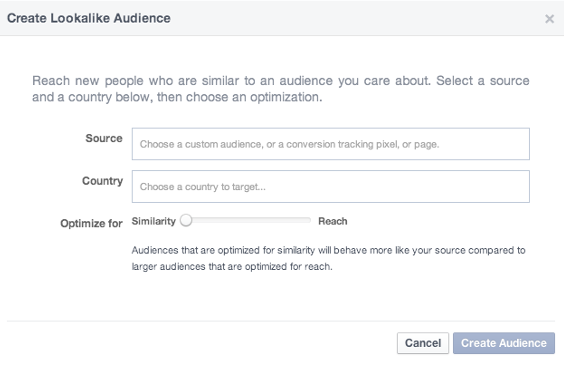
This technique very nicely takes us all the way back up to the beginning of this article.
Lookalike audiences are a great way to target non-leads, non-followers, and non-customers with our content, or, in other words, the top of our sales funnel.
Conclusion
Modern digital marketers are pushing the limits of how we optimize sales funnels. Each day we’re trying new strategies that make it easier for internet users to become leads, and for leads to become customers.
We A/B test religiously, testing the color scheme, copy, and the smallest elements at every stage of our campaigns, from landing pages to online ads to marketing emails. We try new things, like pre-populated form fields, that our competitors might not be doing yet. We are a sector that is never satisfied, and it’s invigorating.
Hopefully, this article has given you some new ideas to consider, or simply a better understanding of why an optimized marketing campaign is worth the time, energy, and resources.
If you’ve found success (or frustration) with a recent marketing campaign, or have any questions about anything I’ve discussed above, don’t hesitate to start a conversation in the comment section below.
About the Author: James Scherer is a content marketer and blogger forWishpond, an internet startup whose tools make online marketing simple from beginning to end. He is the author of several e-books, including “The Complete Guide to Landing Pages.” Connect with him on Twitter and Google+.
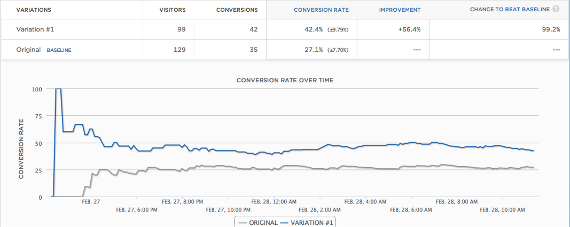


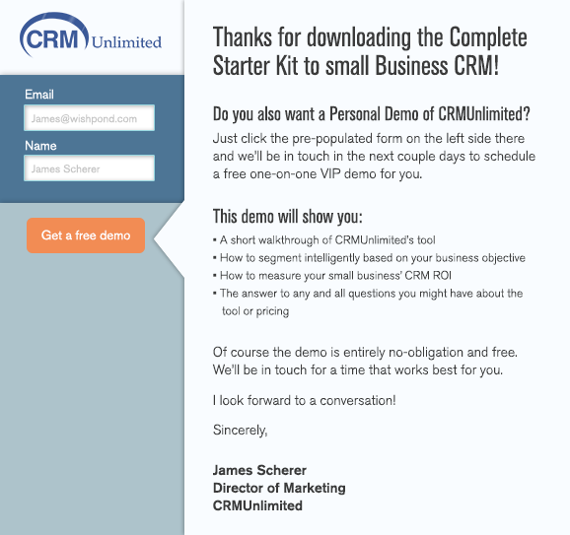
No comments:
Post a Comment